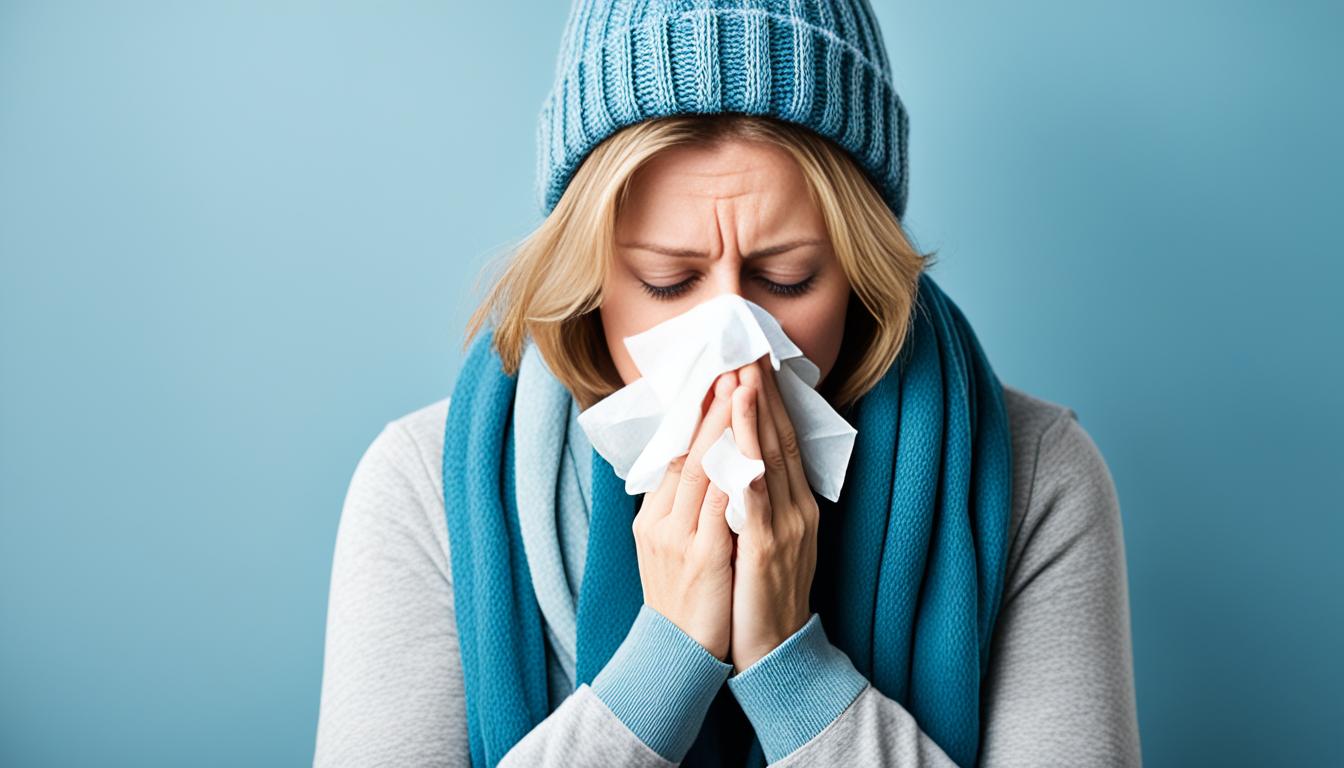Cold allergy is when your body reacts badly to cold temperatures. This can show up as hives, itching, swelling, or even trouble breathing. It happens when you’re around cold air, water, or things like ice. Doctors aren’t sure exactly why it happens but think your immune system is just too sensitive to cold.
Diagnosing cold allergy means doctors look at your health history, do a check-up, and a cold stress test. There’s no cure, but you can lessen how bad it gets. Try to stay warm, wear warm clothes, and take medicine like antihistamines. Lately, using stem cells to treat this allergy seems to be helping. It’s making life better for many with cold allergy.
Key Takeaways:
- Cold allergy is an allergic response to cold temperatures.
- Common symptoms include hives, itchiness, swelling, and difficulty breathing.
- Diagnosis involves medical history, examination, and specific tests.
- Management strategies include avoiding cold temperatures, protective clothing, and antihistamines.
- Stem cell therapy shows promise in reducing symptoms and improving quality of life.
Symptoms and Causes of Cold Allergy
The symptoms of cold allergy can differ from person to person. They often include hives, which are itchy welts, swelling, redness, and itchiness. These appear quickly after being in the cold and might last for hours. In extreme cases, problems like trouble breathing or anaphylaxis may happen. This is a severe allergic reaction needing immediate help.
The exact cause of cold allergies isn’t completely clear but seems to be from the body’s strange reaction to cold. The immune system wrongly sees cold as dangerous. This leads to the release of chemicals, like histamine, causing the allergic reactions. Cold allergy can also happen from touching cold items, cold water, or eating or drinking cold things.
To understand the common symptoms and causes of cold allergy in more detail, refer to the table below:
| Symptoms | Causes |
|---|---|
| Hives | Abnormal immune response to cold temperatures |
| Swelling | Mistaken identification of cold stimulus as a threat |
| Redness | Release of histamine and other chemicals |
| Itchiness | Exposure to cold water, touching cold objects, or eating cold food or drinks |
Knowing these symptoms and causes is very important. It helps in managing and treating cold allergy. Understanding the signs and what causes the condition lets people take the right steps. This includes precautions and seeking medical help to avoid serious allergic reactions.
Diagnosis and Treatment of Cold Allergy
Diagnosing cold allergy means taking a close look at your medical past and symptoms. Doctors also inspect your skin and may do tests. One test is a cold stimulation test. It checks for allergic reactions like hives when a cold object touches your skin. Blood tests are done to look for markers of allergy too.
Treating cold allergy works on managing symptoms and stopping allergic reactions. Avoiding cold as much as possible is key. This means dressing warmly and staying away from cold places.
Antihistamines help reduce itching and swelling. They work by blocking histamine effects during an allergic response. You can take them by mouth or apply them to the skin.
If you have serious cold allergy, always carry an epinephrine auto-injector. This can quickly treat bad reactions. After using it, get medical help right away.
Complementary Therapies and Stem Cell Therapy
Some people find relief in acupuncture for cold allergy. It uses tiny needles at specific body points to help symptoms.
Herbal supplements might also be helpful. But talk to your doctor first to make sure they’re safe and work.
Stem cell therapy is a newer option. It can help regulate the immune system and heal tissue. Research on its benefits for cold allergy is ongoing.
Conclusion
Cold allergy can really change someone’s life, making them uncomfortable and at risk of serious allergic reactions. Even though there’s no cure for it, people can use different methods to handle symptoms and lower their allergic reactions.
Lately, stem cell therapy has been promising for cold allergy treatment. These special cells can help fix tissues and adjust the immune system. This might lower the severe and how often these allergic reactions happen. But, more research is still needed to check how well this treatment works in the long run.
For now, it’s crucial for those with cold allergies to talk to their doctors. Together, they can come up with a plan that fits their needs. This plan might include medicines, changing daily habits, and trying other treatments to feel better and live a fuller life.

